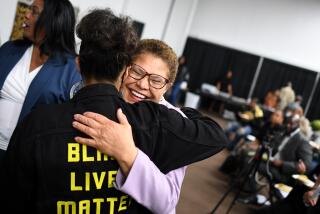An implausible plan to fight terrorism through community outreach
- Share via
Preventing self-radicalized Muslim Americans from engaging in or abetting acts of terrorism is obviously a national priority. But a new Obama administration position paper offers an implausible approach to achieving that objective.
The blueprint, titled “Empowering Local Partners to Prevent Violent Extremism in the United States,” mentions other sorts of terrorism, but its focus is on that fueled by Islamic extremism (though it doesn’t use that term). Its recommendation is that the federal government engage in “strengthening community partnerships and preventing violent extremism … as a facilitator, convener, and source of information.”
The notion is that community initiatives can help ameliorate extremism among young men who might be attracted to the teachings of Al Qaeda. The report draws an analogy with three other community initiatives: anti-gang efforts; liaisons between community groups and the federal government in connection with anti-terrorism efforts; and the Safe Schools/Healthy Students Initiative designed to prevent school violence and drug abuse. In the schools program, the report notes, participating school districts must address violence and substance abuse.
An outreach program for Muslim communities, one that promotes nonviolence and dialogue with the larger society, is not a bad idea. The question is whether it would have much effect on the sort of “lone wolf” terrorists who pose the greatest threat. The report offers no convincing evidence that programs that work with gang members and schoolchildren would also deter violence by jihadists.
Nor is it obvious that, as the report suggests, “good governance programs — including those that promote immigrant integration and civic engagement, protect civil rights, and provide social services — … may help prevent radicalization that leads to violence.” Finally, the report suggests a propaganda effort to challenge justifications of violence and promote “the unifying and inclusive vision of our American ideals.” Praiseworthy as such a message is, delivering it through community outreach or otherwise seems unlikely to influence the behavior of potential terrorists.
To be fair, the report does not suggest community-based approaches as a substitute for investigation by law enforcement of potential terrorists. Indeed, it proposes greater involvement by police with local communities (a form of “community outreach” with a long history). Much of the report makes sense. But the overwhelming emphasis is on community outreach as an inoculation against extremism. That case has not been made.
More to Read
A cure for the common opinion
Get thought-provoking perspectives with our weekly newsletter.
You may occasionally receive promotional content from the Los Angeles Times.









